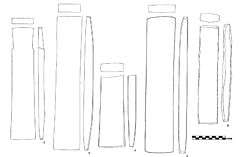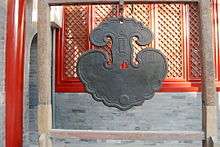Sankarjang


Sankarjang (20°52’08“N; 84°59’19“E), Odisha, India is an archaeological site near Angul, a former cemetery and settlement with large, splendid worked stones. This site was test excavated by the State Archaeology Department of Odisha after a chance find of 20 long unfinished chipped and ground, lithic bars and axes of basalt, together with human skeletal remains and metallic artifacts, by a shepherd in 1971.
Old-fashioned archaeologists understood ground stone lithics to be typical of the Neolithic Period although they were in production later. The elegant lithics from Sankarjang resemble elaborate ones from eastern Asia and the South Seas. Such lithics played a key role in the definition of R. von Heine-Geldern’s Austronesian culture. The incisor teeth of nine bodies interred in the graves had a "shovel" form which suggests Mongolian affinities. The absolute chronology rests on few 14C dates. Many of the stones give a resonance when struck and judging from the use-wear traces and shape, the stone bars appear to have belonged to finished and unfinished lithophones. Yule and Bemmann tentatively identified the stone bars as part of South Asia's earliest known musical instrument.
References
- P. Yule/B.K. Rath/K. Højgaard, Sankarjang ein metallzeitlicher Bestattungsplatz im Dhenkanal Vorgebirge des östlichen Indiens, Anthropos 84, 1989, 107–132, ISSN 0003-5572.
- P. Yule/M. Bemmann, Klangsteine aus Orissa-Die frühesten Musikinstrumente Indiens?, Archaeologia Musicalis 2.1, 1988, 41–50 (also in English und French). http://archiv.ub.uni-heidelberg.de/savifadok/volltexte/2008/177/
- P. Yule/A. Hauptmann/M. Hughes, The Copper Hoards of the Indian Subcontinent: Preliminaries for an Interpretation, Jahrbuch des Römisch Germanischen Zentralmuseums Mainz 36, 1989 [1992], 193–275, ISSN 0076-2741. http://archiv.ub.uni-heidelberg.de/savifadok/volltexte/2009/509/
- Paul Yule, Early Historic Sites in Orissa (Delhi 2006), ISBN 81-89645-44-7. http://archiv.ub.uni-heidelberg.de/savifadok/volltexte/2008/147/ http://archiv.ub.uni-heidelberg.de/savifadok/frontdoor.php?source_opus=147&la=de
| ||||||||
